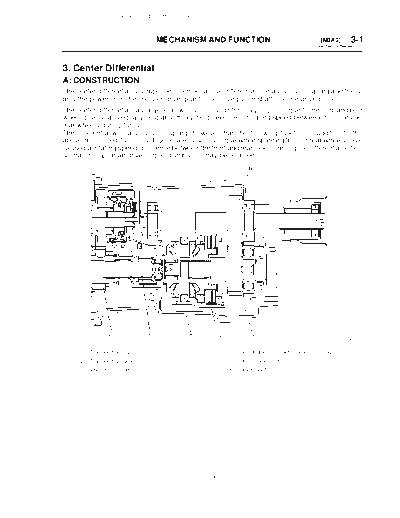Service Manuals, User Guides, Schematic Diagrams or docs for : . Car Manuals Subaru Legacy 2000-2003 Approved Subaru Legacy 2000 2000 Service Manual MECHANISM AND FUNCTION SECTION Manual Transmission and Differential MSA5TCD00L18186
<< Back | HomeMost service manuals and schematics are PDF files, so You will need Adobre Acrobat Reader to view : Acrobat Download Some of the files are DjVu format. Readers and resources available here : DjVu Resources
For the compressed files, most common are zip and rar. Please, extract files with Your favorite compression software ( WinZip, WinRAR ... ) before viewing. If a document has multiple parts, You should download all, before extracting.
Good luck. Repair on Your own risk. Make sure You know what You are doing.
Image preview - the first page of the document

>> Download MSA5TCD00L18186 documenatation <<
Text preview - extract from the document
LEGACY (W2260BE_SGML Complete)
MECHANISM AND FUNCTION [M3A0] 3-1
3. Center Differential
3. Center Differential
A: CONSTRUCTION
The center differential is composed of a mechanical differential and a viscous coupling and trans-
mits the power from the transfer drive gear to the drive pinion shaft and the driven shaft.
The center differential has in general two functions; distributing engine torque to the front and rear
wheel drive shafts equally, and absorbing the difference in rotating speed between the front and
rear wheels during turns.
The differential with a viscous coupling, however, has the following function in addition to the
above-mentioned functions. It generates viscous torque when spinning front or rear wheels have
caused a rotating speed difference between the front and rear axles, limiting the differential action
so that the optimum drive torque distribution may be attained.
B3H1001A
(1) Transfer driven gear (4) Center differential with viscous coupling
(2) Transfer drive gear (5) Drive pinion shaft
(3) Viscous coupling (6) Driven shaft
9
LEGACY (W2260BE_SGML Complete)
3-1 [M3B0] MECHANISM AND FUNCTION
3. Center Differential
B: MECHANISM OF VISCOUS COUPLING
The viscous coupling housing contains a number of inner and outer plates which are arranged
alternately. The inner plate has its internal perimeter fitted to the external side gear (rear) splines
while the outer plate has its external perimeter fitted to the internal center differential case splines.
A spacer ring is provided to position the perimeter of the outer plate. The inner plate has no spacer
ring and moves slightly between the adjacent outer plates, along the side gear (rear) splined in
the axial direction.
A mixture of silicone oil and air is sealed in the space inside the center differential case. An "X"
seal ring prevents silicone oil from entering the transmission. This could occur when silicone oil
is highly pressurized due to an increase in rotating speed difference between the front and rear
wheels.
B3H1002B
(1) X-ring (5) Inner plate
(2) O-ring (6) X-ring
(3) Spacer ring (7) Side gear (rear)
(4) Outer plate
10
LEGACY (W2260BE_SGML Complete)
MECHANISM AND FUNCTION [M3B2] 3-1
3. Center Differential
1. TORQUE CHARACTERISTICS
When a difference in rotating speed between the center differential case and the side gear (rear)
occurs, a viscous shearing force is generated in the silicone oil placed between the outer and inner
plates. The torque is then transmitted by the silicone oil between the center differential case and
the side gear (rear).
The greater the difference in rotating speed between the center differential case and the side gear
(rear), the greater the shearing force of the silicone oil. The relationship between the torque trans-
mission and rotation speed difference is shown in the figure. As can be seen from the figure, the
smaller the rotating speed difference, the lesser the torque transmission and the differential-ac-
tion.
B3H1723A
2. "HUMP" PHENOMENON
Silicone oil is heated and expands as differential action continues. This crushes air inside the vis-
cous coupling so that the silicone oil "charging rate" will increase. As differential action continues,
internal pressure will abruptly increase so that inner and outer plates (alternately arranged) come
in contact. This causes quick torque transmission to occur, which is called a "hump" phenomenon.
The "hump" phenomenon eliminates the rotating speed difference between the center differential
case and side gear (rear) (which results in a state similar to "direct coupling"). This in turn decrease
internal pressure and temperature. The viscous coupling returns to the normal operation. (The
"hump" phenomenon does not occur under normal operating conditions.)
11
LEGACY (W2260BE_SGML Complete)
3-1 [M3C0] MECHANISM AND FUNCTION
3. Center Differential
C: FUNCTION
During normal driving (when there is no speed difference between the front and rear wheels), the
center differential delivers drive power to the front and rear wheels at a torque ratio of 50:50.
When a rotating speed difference occurs between the front and rear wheels, the center differential
action is controlled by viscous coupling so that optimum drive forces are automatically distributed
to the two.
1. DURING NORMAL DRIVING
During normal straight driving (on flat roads at constant speed), all four wheels rotate at the same
speed. The center differential delivers engine torque to the front and rear drive axles. The viscous
coupling does not perform the differential-action control because there is no rotating speed differ-
ence between the front and rear drive shafts.
B3H1003A
2. DURING TURNS AT LOW SPEEDS
During turns at low speeds, a rotating speed difference occurs between the front and rear wheels,
as well as the left and right wheels. In other words, the front wheels rotate faster than the rear
wheels. When there is a small rotating speed difference (when vehicle speed is low), the center
differential acts to absorb the rotating speed difference, making it possible to drive smoothly.
Although a slight rotating speed difference is transmitted to the viscous coupling, less torque
transmission occurs because of the small rotating speed difference.
B3H1004
12
LEGACY (W2260BE_SGML Complete)
MECHANISM AND FUNCTION [M3C3] 3-1
3. Center Differential
3. DRIVING ON ROUGH ROAD AND LOW "◦ Jabse Service Manual Search 2025 ◦ Jabse Pravopis ◦ onTap.bg ◦ Other service manual resources online : Fixya ◦ eServiceinfo